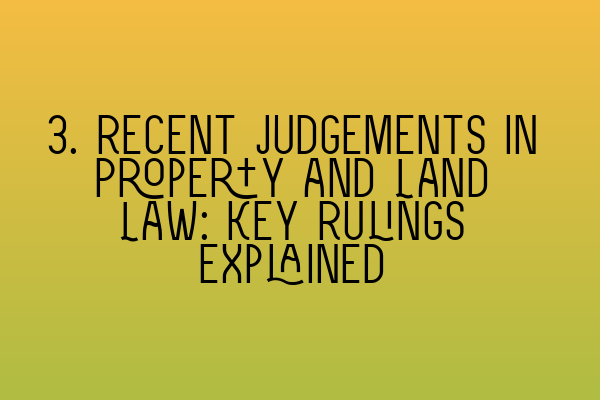**3. Recent Judgements in Property and Land Law: Key Rulings Explained**
At SQE Property Law & Land Law, we pride ourselves on staying up-to-date with the latest legal developments in property and land law. In this blog post, we will take a closer look at three recent judgements that have shaped the landscape of property law in the UK. These key rulings provide important insights for legal professionals, students, and anyone interested in the intricacies of property law. So, let’s dive in!
**1. Ruling on Adverse Possession: A Paradigm Shift**
In a groundbreaking judgement earlier this year, the Supreme Court ruled on an important case related to adverse possession. Adverse possession, in simple terms, allows a person in possession of land without the owner’s consent to claim ownership after a certain period. This ruling marks a paradigm shift in how adverse possession claims will be assessed moving forward.
The case in question involved a piece of land where the true owner had been absent for several years. The occupier, who had been using the land for agricultural purposes, claimed adverse possession. Under the previous legal framework, the adverse possessor had to demonstrate continuous possession for a minimum of 12 years. However, the Supreme Court ruled that intermittent possession could also be considered, as long as it doesn’t undermine the security of the true owner’s possession.
This ruling has far-reaching implications for property practitioners and individuals involved in land disputes. It emphasizes the need for careful consideration of the facts and circumstances surrounding adverse possession claims. Legal professionals will need to adapt their approach to reflect this new precedent, ensuring they provide sound advice and representation to their clients.
**2. Clarity on Neighbour Disputes: Boundaries and Rights of Way**
Neighbourhood disputes can be a major source of stress and tension for property owners. In a recent judgement, the Court of Appeal provided much-needed clarity on the issue of boundaries and rights of way, aiming to resolve common disputes between neighbours.
The ruling reaffirmed the principle that the boundary between properties is presumed to be in the middle of any physical feature, such as a fence or hedge, unless stated otherwise. This presumption helps to simplify the determination of property boundaries, ensuring consistency in interpreting deeds and plans.
Furthermore, the judgement emphasized the importance of clearly defining rights of way. It established that the purpose of a right of way should be determined by its wording and any surrounding circumstances, rather than relying solely on presumed intentions.
This ruling guides property owners, solicitors, and conveyancers in resolving boundary and right of way disputes more efficiently and fairly. It streamlines the process by providing clear guidelines for interpreting deeds and plans, reducing ambiguity and potential conflicts between neighbours.
**3. Leasehold Reform: A Step Towards Fairness**
Leasehold reform has been a growing concern in recent years, with issues such as escalating ground rents and onerous lease terms impacting leasehold property owners. In a significant ruling, the Court of Appeal has taken a step towards fairness in the leasehold sector.
The judgement addressed an important aspect of leasehold reform, focusing on the interpretation of the Right to Manage (RTM) legislation. It clarified that leaseholders seeking to exercise the RTM must only include qualifying premises in their application. Previously, there was uncertainty around whether non-residential premises attached to a residential block could be included.
This ruling provides much-needed clarity for leaseholders looking to take control of the management of their property. It ensures that the RTM legislation is applied consistently and fairly, promoting transparency and empowering leaseholders in their dealings with managing agents and freeholders.
**Stay Informed and Stay Ahead**
Staying informed about recent judgements and legal developments in property and land law is crucial for both professionals and individuals dealing with property matters. These three key rulings highlight the dynamic nature of the legal landscape and the impact they can have on property disputes and transactions.
To further enhance your understanding of property law and prepare for the SQE exams, be sure to explore our related articles:
– [SQE 1 Practice Exam Questions](https://fqps.co.uk/sqe/sqe1-preparation/mcq-practice-quiz)
– [SQE 1 Practice Mocks FLK1 FLK2](https://fqps.co.uk/sqe/sqe1-preparation/practice-mocks-quiz)
– [SQE 2 Preparation Courses](https://fqps.co.uk/sqe/sqe2-preparation)
– [SQE 1 Preparation Courses](https://fqps.co.uk/sqe/sqe1-preparation)
– [SRA SQE Exam Dates](https://fqps.co.uk/sqe/sqe1-sqe2-exam-dates)
At SQE Property Law & Land Law, we are committed to providing you with the latest insights and resources to help you succeed in your legal career. Stay ahead of the curve by staying informed, and remember, knowledge is power in the ever-evolving world of property law.
